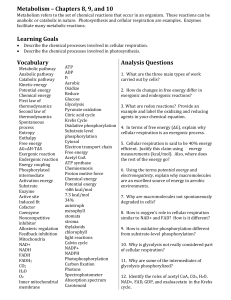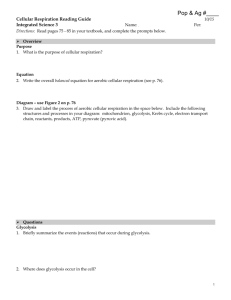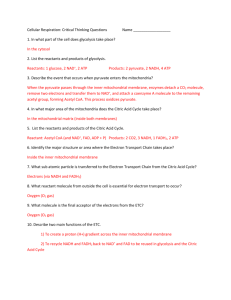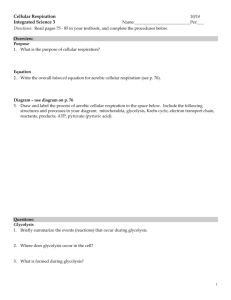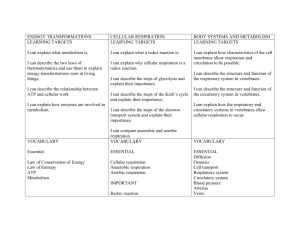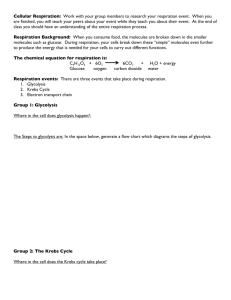Redox and Glycolysis Quiz.wpd
advertisement
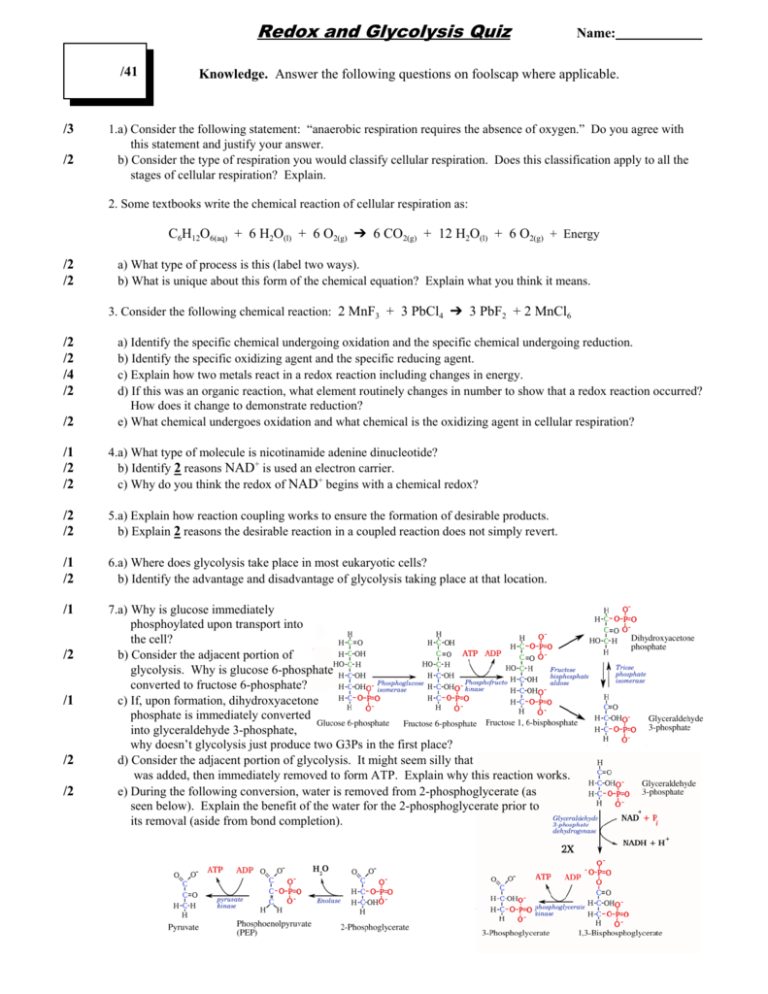
Redox and Glycolysis Quiz /41 /3 /2 Name: Knowledge. Answer the following questions on foolscap where applicable. 1.a) Consider the following statement: “anaerobic respiration requires the absence of oxygen.” Do you agree with this statement and justify your answer. b) Consider the type of respiration you would classify cellular respiration. Does this classification apply to all the stages of cellular respiration? Explain. 2. Some textbooks write the chemical reaction of cellular respiration as: C6H12O6(aq) + 6 H2O(l) + 6 O2(g) ö 6 CO2(g) + 12 H2O(l) + 6 O2(g) + Energy /2 /2 a) What type of process is this (label two ways). b) What is unique about this form of the chemical equation? Explain what you think it means. 3. Consider the following chemical reaction: 2 MnF3 + 3 PbCl4 ö 3 PbF2 + 2 MnCl6 /2 /2 /4 /2 /2 a) Identify the specific chemical undergoing oxidation and the specific chemical undergoing reduction. b) Identify the specific oxidizing agent and the specific reducing agent. c) Explain how two metals react in a redox reaction including changes in energy. d) If this was an organic reaction, what element routinely changes in number to show that a redox reaction occurred? How does it change to demonstrate reduction? e) What chemical undergoes oxidation and what chemical is the oxidizing agent in cellular respiration? /1 /2 /2 4.a) What type of molecule is nicotinamide adenine dinucleotide? b) Identify 2 reasons NAD+ is used an electron carrier. c) Why do you think the redox of NAD+ begins with a chemical redox? /2 /2 5.a) Explain how reaction coupling works to ensure the formation of desirable products. b) Explain 2 reasons the desirable reaction in a coupled reaction does not simply revert. /1 /2 6.a) Where does glycolysis take place in most eukaryotic cells? b) Identify the advantage and disadvantage of glycolysis taking place at that location. /1 7.a) Why is glucose immediately phosphoylated upon transport into the cell? b) Consider the adjacent portion of glycolysis. Why is glucose 6-phosphate converted to fructose 6-phosphate? c) If, upon formation, dihydroxyacetone phosphate is immediately converted into glyceraldehyde 3-phosphate, why doesn’t glycolysis just produce two G3Ps in the first place? d) Consider the adjacent portion of glycolysis. It might seem silly that phosphate was added, then immediately removed to form ATP. Explain why this reaction works. e) During the following conversion, water is removed from 2-phosphoglycerate (as seen below). Explain the benefit of the water for the 2-phosphoglycerate prior to its removal (aside from bond completion). /2 /1 /2 /2 Redox and Glycolysis Quiz /41 /3 Knowledge. Answer the following questions on foolscap where applicable. 1.a) Consider the following statement: “anaerobic respiration requires the absence of oxygen.” Do you agree with this statement and justify your answer. ! ! ! /2 Name: this statement is wrong anaerobic respiration just does not use oxygen in order to proceed but it can (for most organisms) proceed regardless of oxygen levels b) Consider the type of respiration you would classify cellular respiration. Does this classification apply to all the stages of cellular respiration? Explain. ! ! no glycolysis is anaerobic 2. Some textbooks write the chemical reaction of cellular respiration as: C6H12O6(aq) + 6 H2O(l) + 6 O2(g) ö 6 CO2(g) + 12 H2O(l) + 6 O2(g) + Energy /2 a) What type of process is this (label two ways). ! ! /2 redox exergonic b) What is unique about this form of the chemical equation? Explain what you think it means. ! ! water is on both sides the water used and produced must represent significantly different chemicals 3. Consider the following chemical reaction: 2 MnF3 + 3 PbCl4 ö 3 PbF2 + 2 MnCl6 /2 a) Identify the specific chemical undergoing oxidation and the specific chemical undergoing reduction. ! ! /2 b) Identify the specific oxidizing agent and the specific reducing agent. ! ! /4 the metal with the stronger attraction for electrons steals electrons from the other metal as a result the electrons now have less potential energy since they are more strongly held by the nucleus d) If this was an organic reaction, what element routinely changes in number to show that a redox reaction occurred? How does it change to demonstrate reduction? ! ! /2 oxidizing agent = Pb4+ reducing agent = Mn3+ c) Explain how two metals react in a redox reaction including changes in energy. ! ! /2 oxidation = Mn3+ reduction = Pb4+ hydrogen atoms increases in number e) What chemical undergoes oxidation and what chemical is the oxidizing agent in cellular respiration? ! ! oxidation = glucose oxidizing agent = oxygen /1 4.a) What type of molecule is nicotinamide adenine dinucleotide? ! /2 b) Identify 2 reasons NAD+ is used an electron carrier. ! ! ! /2 ! ! the energized glucose 6-phosphate is now trapped in the cell b) Consider the adjacent portion of glycolysis. Why is glucose 6-phosphate converted to fructose 6-phosphate? ! ! /1 under anaerobic conditions, some energy is quickly and continually harvested for immediate use by the cell to ensure its survival (at least for a while) the NADH formed cannot be converted directly into ATP until is somehow crosses into the mitochondria and in doing so, some of its energy is lost 7.a) Why is glucose immediately phosphoylated upon transport into the cell? ! /2 cytosol b) Identify the advantage and disadvantage of glycolysis taking place at that location. ! /1 if this reaction is endergonic, the activation energy of the reverse reaction is higher and so the reverse reaction is less spontaneous often in biochemical pathways, the products of one reaction are immediately picked up by a nearby enzyme to initiate the next reaction (like joined train cars all pull together once one begins moving) 6.a) Where does glycolysis take place in most eukaryotic cells? ! /2 some of the energy from an exergonic reaction is used as activation energy for a desirable reaction (which may or may not be exergonic or endergonic, but the activation energy must be less than the released energy from the coupled reaction–to allow for wasted energy due conversion) b) Explain 2 reasons the desirable reaction in a coupled reaction does not simply revert. ! /1 accepting a hydrogen atom with its electron, increases the attraction for electrons so it can steal another electron from an organic molecule 5.a) Explain how reaction coupling works to ensure the formation of desirable products. ! ! /2 the conversion from NAD+ ö NADH+ requires very little energy which means the most potential energy possible is captured also could say it is one of the most versatile molecules in our bodies (but this is not a good answer) c) Why do you think the redox of NAD+ begins with a chemical redox? ! ! /2 coenzyme it weakens a bond to allow the addition of another phosphate which creates a molecule, fructose 1,6-diphosphate which can be more easily split in two c) If, upon formation, dihydroxyacetone phosphate is immediately converted into glyceraldehyde 3-phosphate, why doesn’t glycolysis just produce 2 G3Ps in the first place? ! fructose 1,6-diphosphate is not symmetrical so when it splits, the product is 2 different molecules /2 d) Consider the adjacent of portion glycolysis. It might seem silly that phosphate was added, then immediately removed to form ATP. Explain why this reaction works. ! ! /2 the phosphate added was inorganic phosphate free in the cytosol so this did not require any energy but all the electronegative oxygen atoms present destablized the the 1,3 bisphosphoglycerate enough to allow ATP to form e) During the following conversion, water is removed from 2-phosphoglycerate (as seen below). Explain the benefit of the water for the 2-phosphoglycerate prior to its removal (aside from bond completion). ! ! the OH from the water on the bottom carbon allows hydrogen bonding to take place with the O in the phosphate to stabilize the molecule so it can contain the phosphate Prepared by K. Zuber

